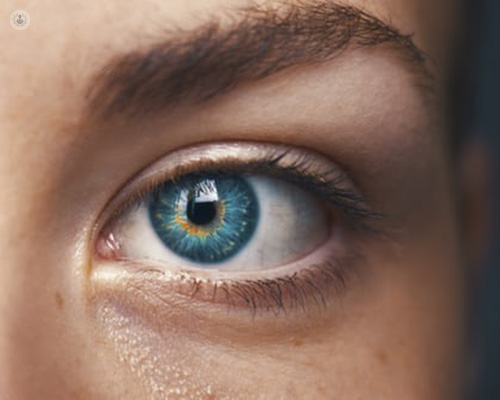Retinitis pigmentosa
Mr Raj Mukherjee - Ophthalmology
Created on: 11-13-2012
Updated on: 01-05-2024
Edited by: Aoife Maguire

What is retinitis pigmentosa?
Retinitis pigmentosa is a group of eye diseases that affects peripheral and night vision and can lead to loss of sight. It develops as a result of certain genetic disorders that can cause the breakdown of cells in the retina.
The retina, which is at the back of the eye, converts light into signals to the brain and gives us the ability to see. If these photoreceptor cells in the retina begin to degenerate, there will be a gradual decline in vision. This starts with someone struggling to see at night and then losing their peripheral vision.
What are the symptoms of retinitis pigmentosa?
The condition starts in childhood but it depends on the individual as to when and how quickly it gets worse. Most people tend to have lost much of their sight by early adulthood. By age 40, they are blind.
Symptoms usually begin with poor night vision as the cells in charge of seeing in dim light begin to stop working. Normally it takes 20 minutes to adapt to low-light conditions but with retinitis pigmentosa, it can take much longer or not even happen at all.
As the eye condition progress, the cones which are the cells that respond to light will stop working also. These are used for peripheral vision and losing these will result in ‘tunnel vision’ and it is a struggle to see to the sides, and above or below when you look forward.
What causes retinitis pigmentosa?
Most cases of retinitis pigmentosa are hereditary. There are three main ways in which the condition can be passed from parent to child:
- Autosomal recessive inheritance – which is a result of two copies of the mutated gene being present as both parents are carriers.
- Autosomal dominant inheritance – caused because one parent has a dominant gene mutation. There is a 1 in 2 chance of the child inheriting and developing it.
- X-linked inheritance – occurs in the parent with retinitis pigmentosa linked to their X chromosome, there is a 1 in 2 chance of their son developing it and the same odds of their daughter being a carrier.
How is retinitis pigmentosa diagnosed?
An ophthalmologist will do some special tests to detect the condition. He will perform an ophthalmoscope, which involves a handheld tool that looks into the back of your eye to check for dark spots.
You will also need to do a visual field test, where you look through a tabletop machine at a point in the centre of your vision. Objects or lights will appear to the side and you will have to press a button when you see them.
An electroretinogram may also be performed so that the doctor can measure how your retina responds to flashes of light.
Finally, you will have to submit a DNA sample to find out which form of the condition that you have.
How is retinitis pigmentosa treated?
There is no cure for retinitis pigmentosa but a few options can slow vision loss and may even restore some sight. A team of professionals, including opthalmologists can help you manage your vision by training you on how to stay mobile and perhaps help you with a guide dog.


